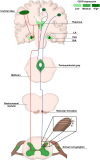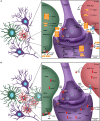Cannabinoid Therapeutics in Chronic Neuropathic Pain: From Animal Research to Human Treatment
- PMID: 34916962
- PMCID: PMC8669747
- DOI: 10.3389/fphys.2021.785176
Cannabinoid Therapeutics in Chronic Neuropathic Pain: From Animal Research to Human Treatment
Abstract
Despite the importance of pain as a warning physiological system, chronic neuropathic pain is frequently caused by damage in the nervous system, followed by persistence over a long period, even in the absence of dangerous stimuli or after healing of injuries. Chronic neuropathic pain affects hundreds of millions of adults worldwide, creating a direct impact on quality of life. This pathology has been extensively characterized concerning its cellular and molecular mechanisms, and the endocannabinoid system (eCS) is widely recognized as pivotal in the development of chronic neuropathic pain. Scientific evidence has supported that phyto-, synthetic and endocannabinoids are efficient for pain management, while strong data arise from the therapeutic use of Cannabis-derived products. The use of medicinal Cannabis products is directed toward not only relieving symptoms of chronic pain, but also improving several aspects of patients' welfare. Here, we review the involvement of eCS, along with other cellular and molecular elements, in chronic neuropathic pain pathology and how this system can be targeted for pain management.
Keywords: THC; cannabidiol; cannabis; endocannabinoid; neuropathic pain.
Copyright © 2021 Campos, Aguiar, Paes-Colli, Trindade, Ferreira, de Melo Reis and Sampaio.
Conflict of interest statement
The authors declare that the research was conducted in the absence of any commercial or financial relationships that could be construed as a potential conflict of interest.
Figures


References
-
- Abraham A. D., Leung E. J. Y., Wong B. A., Rivera Z. M. G., Kruse L. C., Clark J. J., et al. (2020). Orally consumed cannabinoids provide long-lasting relief of allodynia in a mouse model of chronic neuropathic pain. Neuropsychopharmacology 45 1105–1114. 10.1038/s41386-019-0585-3 - DOI - PMC - PubMed
-
- Aviram J., Samuelly-Leichtag G. (2017). Efficacy of Cannabis-based medicines for pain management: a systematic review and meta-analysis of randomized controlled trials. Pain Physician 20 E755–E796. - PubMed
Publication types
LinkOut - more resources
Full Text Sources

